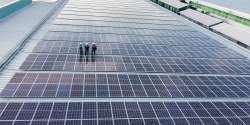Read Time : 3 Minutes
Solar PV - Difference in monocrystalline & polycrystalline
Crystalline silicon solar panels are currently the most popular option for home use on the market. However, what many forget is that while these two types are similar, they also have a range of differences. Here is some further information on monocrystalline and polycrystalline solar panel, as well as how silicon solar cells work.
How Do Silicon Solar Cells Work?
The primary component of a solar cell is silicon. This has been used as an essential part of electrical items for decades. They are often referred to as first generation solar panels, and they currently make up over 90% of the solar cell market. The reason that they are known as first generation solar panels is due to the fact that silicon solar cell technology had already started gaining traction in the 1950s. As a result, it is the first form of solar cell technology. However, pure crystalline silicon is actually a very poor conductor of electricity. This is because it is a semiconductor material at its core. The silicon that is found in a solar cell actually has a number of impurities – this is so that the other atoms are purposely mixed with the silicon ones. What this does is address the conduction issues that silicon presents, as the newly mixed atoms work to improve the silicon’s ability to capture energy from the sun and convert it into electricity. An atom of gallium has one less electron than an atom of silicon, while an arsenic atom has one extra electron. When the arsenic atoms are placed between silicon atoms, there are extra electrons in the structure as a result. Therefore, an electron-rich layer is formed. When you use gallium atoms instead, the result is a lack of electrons. What this means is that a poor electron layer will be created. In a solar cell, the layers are placed next to each other, and it is this that creates an electric field. When the sunlight hits the solar cells, the energy stimulates the electrons, and this results in holes being left behind. These then migrate to the electrodes in the cells because of the presence of the electric field. As a result, electricity is created.
COMPARE PRICES FROM LOCAL INSTALLERS
Compare prices from local companies fast & free
Enter your postcode to compare quotes from leading professionals. We promise to keep your information Safe & Secure. Privacy Policy
Monocrystalline Solar Cells
The monocrystalline solar cells are also known as single crystalline cells. They are incredibly easy to identify because they are a dark black in colour. Monocrystalline cells are made from an incredibly pure form of silicon, which makes them the most efficient material for the conversion of sunlight into energy. Additionally, monocrystalline cells are also the most space-efficient form of silicon solar cell. They also have the advantage of being the ones that last the longest out of all the silicon-based solar cells. In fact, many manufacturers will offer warranties of up to 25 years on this type of system – a warranty that lasts half of their expected life. However, while these systems are superior, they do come at quite a hefty price. Monocrystalline cells are the most expensive option out of all of the silicon solar cell types, mostly because the four-sided cutting system results in a large amount of waste. Polycrystalline acts as a cheaper alternative. Here are some of the advantages of monocrystalline solar cells:
- They have the highest level of efficiency at 15-20%
- They require less space compared to other types due to their high efficiency
- Manufacturers state that this form of solar cell lasts the longest, with most giving them a 25-year warranty
- They perform better in low levels of sunlight, making them ideal for cloudy areas
Here are some of the disadvantages to monocrystalline solar cells:
- They are the most expensive solar cells on the market, and so not in everyone’s price range
- The performance levels tend to suffer from an increase in temperature. However, it is a small loss when compared to other forms of solar cell
- There is a lot of waste material when the silicon is cut during manufacture
Polycrystalline Solar Cells
The polycrystalline solar cells are also known as polysilicon and multi-silicon cells. They were the first solar cells to be developed when the industry started in the 1980s. Most interestingly, polycrystalline cells do not undergo the same cutting process as the monocrystalline cells. Instead, the silicon is melted and then poured into a square mould. This is what creates the specific shape of the polycrystalline. One of the benefits of this process is that the solar cells become much more affordable. This is because hardly any silicon is wasted during the manufacturing process. However, they are less efficient than monocrystalline solar cells, and also require a lot more space. This is due to the fact that they have lower levels of purity than the single crystalline cell models. Polycrystalline also has a lower tolerance for heat than monocrystalline. This means that they are unable to function as efficiently in high temperatures. This can be a massive disadvantage in areas with hot climates. Here are some of the advantages of polycrystalline solar cells:
- The manufacturing process is cheaper and easier than the monocrystalline cells
- It avoids silicon waste
Here are some of the disadvantages to polycrystalline solar cells:
- High temperatures have less negative effects on efficiency compared with monocrystalline cells. This makes the polycrystalline cells more attractive to people in warmer areas as the price is lower
- Efficiency is only around 13-16% due to low levels of silicon purity. So they are not the most efficient on the market
- They have lower output rates which make them less space efficient. So more roof space is needed for installation
Want to Know More?
Have you found yourself interested in solar panels? If you want to know more then make sure you head to our marketplace where you can find our full range of products, each with the relevant information. Or simply give us a ring using the number at the top of this page and have a chat.
Find a local installer
Welcome to the biggest directory of UK renewable energy companies





 How Much do Solar Panel Systems Cost in 2024?
How Much do Solar Panel Systems Cost in 2024?







